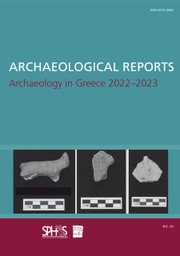Article contents
The Work of the British School at Athens, 2012–20131
Published online by Cambridge University Press: 19 November 2013
Extract
The School's archaeological programme in 2012–2013 included fieldwork, museum studies (notably a project led by Robin Barber to complete the publication of material from early 20th-century excavations at Phylakopi now held in the National Museum in Athens) and many individual and group projects housed at Knossos and in the Fitch Laboratory. Following the success of the conference Interpreting the Seventh Century BC, in December 2011, a further workshop in December 2012 on Thessalian sanctuaries and cults, organized in collaboration with the University of Oxford, brought together 24 speakers, including many colleagues from Thessalian ephoreias and the University of Thessaly, to present new data and reflections. Maria Stamatopoulou comments further on material presented at this meeting in her contribution to this year's AG below. In London, collaboration with colleagues in the British Museum's Department of Greece and Rome resulted in a very popular study day on Knossos: from Labyrinth to Laboratory in November 2012 (now published online at www.bsa.ac.uk). This will soon be followed (on 2 November 2013) by a further collaboration in a British Museum Classical Colloquium on Archaeology Behind the Battle Lines: Macedonia 1915–1919, also in partnership with the Archaeological Museum of Thessaloniki.
Among our ongoing field projects, I begin with discussion of the excavation at Koutroulou Magoula in Thessaly directed by Nina Kyparissi-Apostolika (Director Emerita, EPSNE) and Yannis Hamilakis (Southampton), which in 2012 sought to clarify activity in the area of two Neolithic buildings uncovered in 2011 (Fig. 2). One of these buildings had been mostly destroyed in later periods, although evidence of outdoor activity includes hearths and in situ deposits.
- Type
- Archaeology in Greece 2012–2013
- Information
- Copyright
- Copyright © Authors, the Society for the Promotion of Hellenic Studies and the British School at Athens 2013
Footnotes
The following account draws on reports of British School activities presented at the Archaeological Society of Athens (by courtesy of the General Secretary, Dr Vassileios Petrakos), the Aristotle University, Thessaloniki (by courtesy of the Department of History and Archaeology) and the British Academy. Further details of the School and its activities may be found in the Annual Report, published online at www.bsa.ac.uk. The School's programme is made possible by the close collaboration of many colleagues in the Ministry of Culture. Particular thanks are due to the Secretary General, Dr Lina Mendoni, the Director General of Antiquities, Dr Maria Andreadaki-Vlazaki, and the directors in those regions where our major projects took place: Dr Stella Chrysoulaki in Piraeus, Mrs Ekaterini Dellaporta and Dr Panagiotis Hatzidakis in the Cyclades, Dr Paraskevi Kalamara in Chalkis, Dr Athanasia Kanta in Herakleion, Dr Alkistis Papadimitriou in Nauplion and Sparta, Dr Maria-Photeini Papakonstantinou in Lamia, Dr Angeliki Simosi of the EMA, Mrs Chryssa Sophianou in Agios Nikolaos and Mr Andreas Soteriou in Argostoli.
References
1 The following account draws on reports of British School activities presented at the Archaeological Society of Athens (by courtesy of the General Secretary, Dr Vassileios Petrakos), the Aristotle University, Thessaloniki (by courtesy of the Department of History and Archaeology) and the British Academy. Further details of the School and its activities may be found in the Annual Report, published online at www.bsa.ac.uk. The School's programme is made possible by the close collaboration of many colleagues in the Ministry of Culture. Particular thanks are due to the Secretary General, Dr Lina Mendoni, the Director General of Antiquities, Dr Maria Andreadaki-Vlazaki, and the directors in those regions where our major projects took place: Dr Stella Chrysoulaki in Piraeus, Mrs Ekaterini Dellaporta and Dr Panagiotis Hatzidakis in the Cyclades, Dr Paraskevi Kalamara in Chalkis, Dr Athanasia Kanta in Herakleion, Dr Alkistis Papadimitriou in Nauplion and Sparta, Dr Maria-Photeini Papakonstantinou in Lamia, Dr Angeliki Simosi of the EMA, Mrs Chryssa Sophianou in Agios Nikolaos and Mr Andreas Soteriou in Argostoli.
- 1
- Cited by




